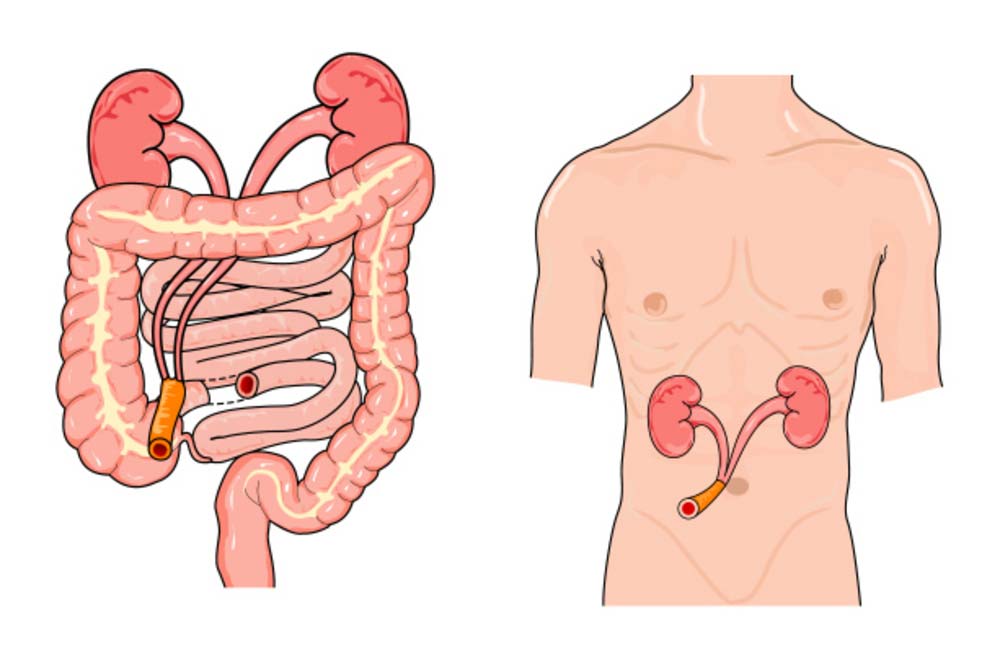Urostomy

Urostomy or “urethral diversion“
A stoma is performed after the bladder has been surgically removed or if it no longer works for some reason. During this procedure, the surgeon makes an opening in your abdomen called a stoma. A piece of bowel is then used to remove urine from the body through that opening.
Urostomy is one of the most common surgeries used in the treatment of bladder cancer.
An alternative to a urostomy is called a “urethral diversion”. In this procedure, the surgeon uses a piece of intestine to create a bag that traps urine inside the body. The urine is then drained either into the bag or this piece of bowel may be used to replace the bladder. This operation targets those whose bladder has been removed for several reasons, including:
- Bladder Cancer.
- Birth with a congenital defect such as spina bifida or bladder exstrophy (bladder eversion).
- Damage to the nerves that control the bladder.
- Chronic cystitis.
- Spinal cord injury.
Preparations for urostomy:
Conducting tests before surgery to ensure sufficient physical health to perform the operation, including:
- Blood tests.
- Electrocardiogram (EKG).
- Take an x-ray of the chest.
The doctor marks the stoma area on the abdomen and this area should be flat in shape, and the patient needs to follow a liquid diet the day before the surgery, and the abdominal area should be showered and washed with antibacterial soap.
The doctor must also know before the operation about any medical prescription and medications the patient is taking, and also the patient should stop taking any blood thinners or other medications a week or so before the surgery. It is also desirable to quit smoking before the surgery because it reduces the risks and improves recovery. .
Steps for urostomy:
The operation takes place while the patient is under general anesthesia, and the procedure begins with the surgeon cutting a small piece of the patient’s large intestine (ileum), then reconnecting the rest of the patient’s intestines together so that he can defecate normally.
Then one end (the ileum) is connected to the ureters (which are the tubes through which urine travels from the kidneys to the bladder), and the other end is connected to the stoma, where the urine travels from the ureters through the ileum to a bag that the patient wears outside his body.
The surgery takes from three to five hours, and after the operation is completed, the patient is transferred to a special care room to wake up and recover from anesthesia, and then the patient remains in the hospital’s inpatient department for a few days after that.
Postoperative recovery period:
After the operation is completed, the patient is placed a drain to remove fluids from the abdomen, and he may not be able to eat solid foods for a few days, as the patient is fed by giving intravenous nutrients and is also given pain relievers.
The patient will stay in the hospital for four to seven days after surgery and after that period the patient will be discharged so that he will be able to walk when he returns home.
Attention must be paid to avoid strenuous activities and not to lift anything heavier than 10 kg for about four weeks.
Wound care method:
Wash the wound area with an antibacterial soap without additives, then dry it well.
Before the wound is completely healed, it is not possible to take a shower or remove the medical dressing.
The color of the stoma is red or pink after surgery.
The stoma shrinks in size over six to eight weeks, and he or she may be asked to measure its size once a week to see if it is growing or shrinking.
A bag and skin septum of the appropriate size should be used for the stoma. If the opening is too small, this leads to compression and damage to the stoma. If it is large, urine may leak from under it and irritate the skin.
It is important to change the bag regularly to avoid irritation or urine leakage. It is preferable to empty the bag when it is half or one-third full.
The skin around the stoma is also cleaned with water and left to dry when changing the bag.
The patient is shown how to care for the stoma after surgery.
Side effects and complications of urostomy:
Bleeding from the area around the stoma is normal, but you should see a doctor if:
- The source of the bleeding was from entering the stoma.
- The bleeding does not stop within 5 to 10 minutes.
The genitals and legs may swell and some fluid may drain through the penis or vagina for a few days after surgery.
Other potential risks include:
- infection
- blood clots
- Pneumonia
You should also see a doctor if:
- Heavy bleeding from the stoma opening.
- Skin sores or severe skin irritation.
- A change in the size of the stoma, especially if it suddenly becomes larger or smaller by half an inch or more.
- Stoma is purple, black or white.
- Strong odor coming from the stoma.
- Swelling or pain in the abdominal area.
- Fever.
- Bloody or foul-smelling urine.
Life with a uroostomy bag:
It may take some time for the patient to get used to living with the ostomy bag but eventually the patient gets used to its quality and most of the patients return to their normal routine after a while.
